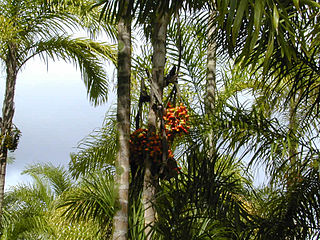
Bactris is a genus of spiny palms which are native to Mexico, South and Central America and the Caribbean. Most species are small trees about 2 m tall, but some are large trees while others are shrubs with subterranean stems. They have simple or pinnately compound leaves and yellow, orange, red or purple-black fruit. The genus is most closely related to several other spiny palms—Acrocomia, Aiphanes, Astrocaryum and Desmoncus. The fruit of several species is edible, most notably B. gasipaes, while others are used medicinally or for construction.

Livistona is a genus of palms, the botanical family Arecaceae, native to southeastern and eastern Asia, Australasia, and the Horn of Africa. They are fan palms, the leaves with an armed petiole terminating in a rounded, costapalmate fan of numerous leaflets.
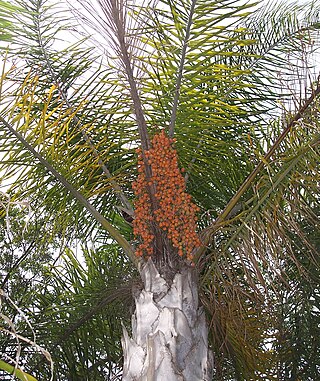
Syagrus is a genus of Arecaceae (palms), native to South America, with one species endemic to the Lesser Antilles. The genus is closely related to the Cocos, or coconut genus, and many Syagrus species produce edible seeds similar to the coconut.

Archontophoenix alexandrae, commonly known as Alexandra palm, king palm, Northern Bangalow palm, or feather palm, is a palm endemic to Queensland, Australia. It was named in honour of Princess Alexandra of Denmark, but is often erroneously referred to by the misnomer Alexander palm.

Actinokentia is a genus of flowering plants in the family Arecaceae, comprising two species, both indigenous to New Caledonia. Relationships between Actinokentia and the other genera of subtribe Archontophoenicinae, including the Australian Archontophoenix and the New Caledonia endemic Chambeyronia and Kentiopsis are unresolved.

Carpoxylon macrospermum is a species of palm tree endemic to Vanuatu, and the only species in the genus Carpoxylon.
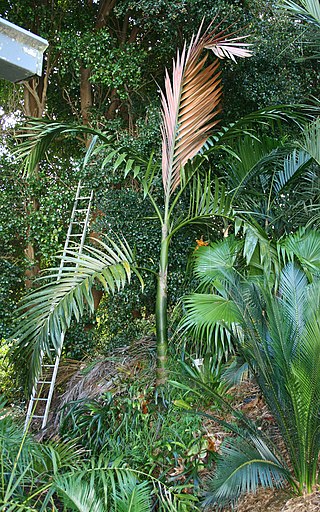
Chambeyronia is a genus of flowering plants in the family Arecaceae. It contains the following species, both endemic to New Caledonia: Relationships between Chambeyronia and the other genera of subtribe Archontophoenicinae, including the Australian Archontophoenix and the New Caledonia endemic Actinokentia and Kentiopsis are unresolved.

Cyphophoenix is a genus of flowering plant in the family Arecaceae. It contains 4 known species, all endemic to New Caledonia. The relationships between Cyphophoenix and some other genera of the tribe Basseliniinae including Physokentia and the New Caledonia endemic Burretiokentia are not clear.

Hedyscepe canterburyana, the big mountain palm or umbrella palm, is the sole species in the genus Hedyscepe of the family Arecaceae. It is endemic to Lord Howe Island, Australia and is threatened by habitat loss. It is a solitary palm with a distinct crownshaft, and bears unisexual flowers of both sexes. With the Rhopalostylis palms of Norfolk Island and New Zealand it forms the botanic subtribe Rhopalostylidinae. If differs from Rhopalostylis in minor floral details including having more than six stamens, and in being protandrous rather than protogynous. The two genera were formerly included in Archontophoenicinae until a recent revision. In some molecular phylogenetic analyses, Hedyscepe was found to be nested in the New Caledonia endemic Basselinia.
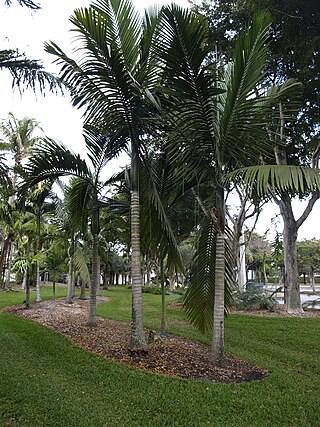
Kentiopsis is a genus of palm trees endemic to New Caledonia. Relationships between Kentiopsis and the other genera of subtribe Archontophoenicinae, including the Australian Archontophoenix and the New Caledonia endemic Chambeyronia and Actinokentia are unresolved.

Linospadix is a genus of flowering plant in the family Arecaceae. It is native to New Guinea and Australia.

Neoveitchia is a genus of palm trees. It contains two known species, native to certain islands in the western Pacific:

Ptychosperma macarthurii, commonly known as the Macarthur palm, is a species of tree in the palm family Arecaceae. Its native range is northern Cape York Peninsula in Queensland with a number of disjunct populations in the Northern Territory and New Guinea. The species has been widely planted in tropical areas and is commonly grown as an indoor plant.

Archontophoenix cunninghamiana is an Australian palm. It can grow over 20 m tall. Its flower colour is violet and the red fruits are attractive to birds. It flowers in midsummer and has evergreen foliage.

Hydriastele is a diverse and widespread genus of flowering plant in the palm family found throughout northern Australia, Melanesia, Polynesia, and Southeast Asia. It consisted of just nine species until 2004, when molecular research, supported by morphologic similarities, led taxonomists to include the members of the Gulubia, Gronophyllum, and Siphokentia genera. About 40 species are now recognized.
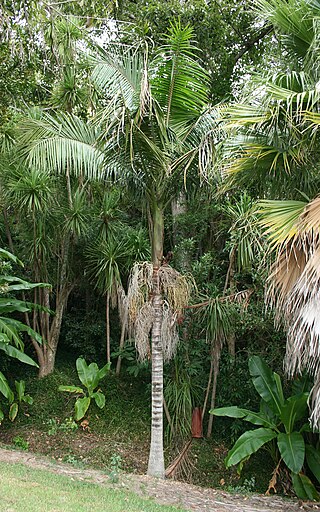
Archontophoenicinae is a botanical subtribe consisting of four genera of palms, namely Archontophoenix from Queensland and New South Wales and Actinokentia, Chambeyronia and Kentiopsis from New Caledonia. Phylogenetic relationships between the four genera are unresolved.

Archontophoenix maxima, the Walsh River palm, is the largest species of the genus Archontophoenix. It is endemic to Queensland, Australia. This robust palm grows in rainforest in altitudes of between 800 and 1,200 m on the Walsh River and the adjacent Mount Haig Range in the Atherton Tablelands at approximately 17° South latitude.

Rhopalostylidinae is a botanical subtribe consisting of two genera of palms from Australia and New Zealand, Hedyscepe and Rhopalostylis. These two genera were formerly included in Archontophoenicinae, to which they are morphologically similar, until a recent revision.
John Leslie Dowe is an Australian botanist who specialises in palms.



















